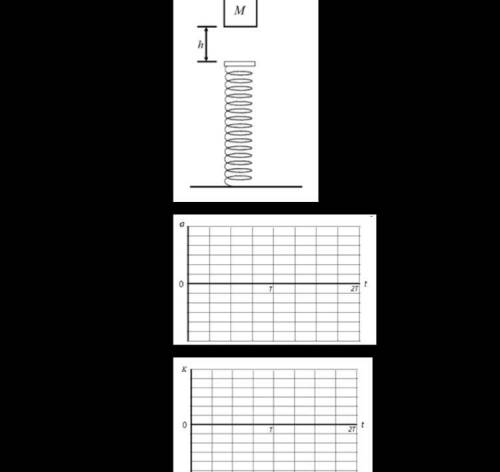
Physics, 15.05.2021 19:40 ajm1132005
In the figure above, an object of mass M = 2.1 kg is dropped from a distance h = 0.43 meter above an uncompressed spring. The spring has a constant of k = 210 N/m. The object becomes attached to the spring upon collision.
(a) Calculate the speed of the object when it collides with the spring.
(b) Determine how far the spring has moved when the object reaches maximum speed.
(c) On the grid below make a graph of the acceleration a of the block as a function of time t for two oscillations. The horizontal axis is scaled for the values of time T and 2T where T is the period of oscillation. Let t = 0 when the object is at its lowest position.
(d) On the grid below make a graph of the kinetic energy K of the block as a function of time t for two oscillations. The horizontal axis is scaled for the values of time T and 2T where T is the period of oscillation. Let t = 0 when the object is at its lowest position.
(e) Describe how the period of oscillation of the object could be changed to one-half its current value. Explain your reasoning.


Answers: 2
Another question on Physics

Physics, 22.06.2019 17:00
In the future, people will only enjoy one sport: electrodisc. in this sport, you gain points when you cause metallic discs hovering on a field to exchange charge. you are an electrodisc player playing the popular four disc variant. the disks have charges of qa = −8.0 µc, qb = −2.0 µc, qc = +5.0 µc, and qd = +12.0 µc. (1) you bring two disks together and then separate them. you measure the resulting charge of these two disks and find that it is +5.0 µc per disk. which two disks did you bring together? (a) a and b (b) a and c (c)a and d (d)b and c(e) b and d (f) c and d. (2) you bring three disks together and then separate them. you measure the resulting charge of these three disks and find that it is +3.0 µc per disk. which three disks did you bring together? a, b, and c (a) a, b, and d (c) a, c, and d (d) b, c, and d. (3) given the resulting charge of each disk measured in (b) is +3.0 µc, how many electrons would you need to add to a disk of this charge to electrically neutralize it? electrons
Answers: 3

Physics, 22.06.2019 23:20
Acharge q experiences no net force at a particular point in space. which of the following situations described below must always be true? -there are no other charges nearby. -if there are other charges nearby, they must all have the same sign as q. -if there are other charges nearby, they must all have the opposite sign of q. -if there are other charges nearby, the total positive charge must equal the total negative charge. -none of the above
Answers: 2

Physics, 23.06.2019 00:30
Diego kicks a soccer ball from the end line. his fellow students time and mark the soccer ball as it moves down the field. the graph represents the ball's progress. based on the graph, during what time is the velocity constant and positive?
Answers: 1

Physics, 23.06.2019 12:30
Acar's position in relation to time is plotted on the graph. what is the car's average velocity for segment c? a) -4 m/s b) -0.25 m/s c) 0.25 m/s d) 4 m/s
Answers: 1
You know the right answer?
In the figure above, an object of mass M = 2.1 kg is dropped from a distance h = 0.43 meter above an...
Questions


Mathematics, 24.11.2021 08:20


Mathematics, 24.11.2021 08:20

History, 24.11.2021 08:20


English, 24.11.2021 08:20

Spanish, 24.11.2021 08:20



Chemistry, 24.11.2021 08:20

Social Studies, 24.11.2021 08:30


Mathematics, 24.11.2021 08:30




SAT, 24.11.2021 08:30




